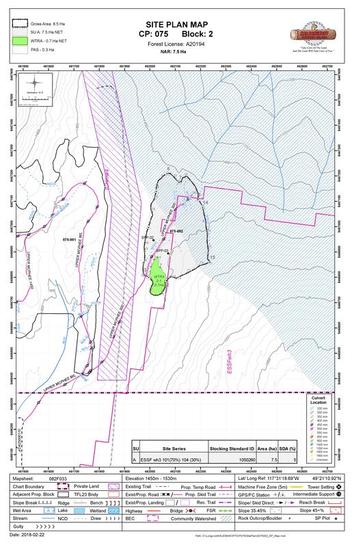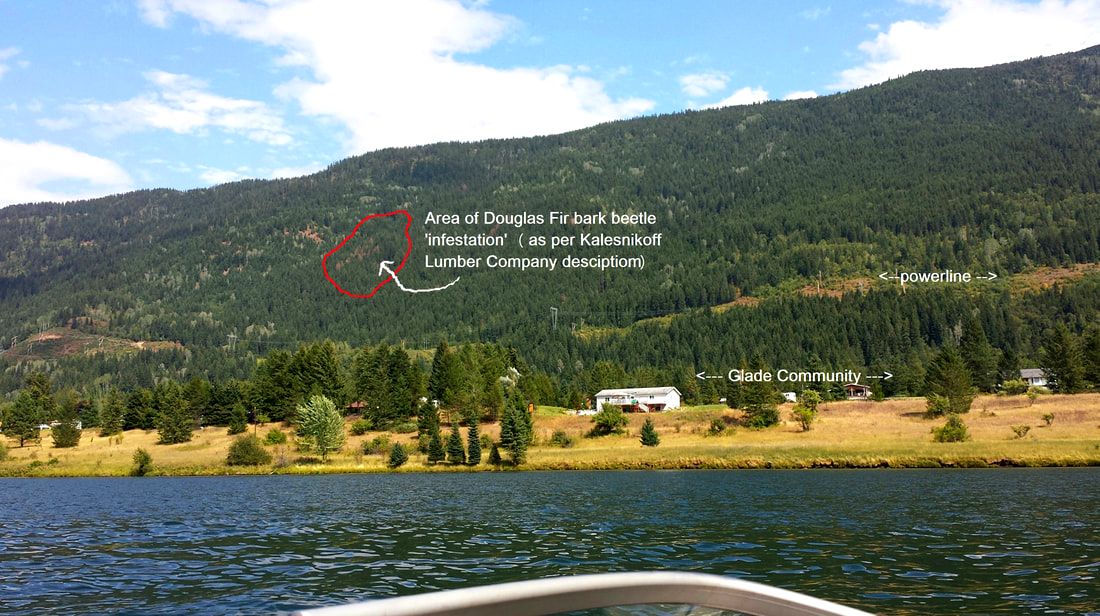Kalesnikoff has started road building into the Glade Creek Watershed
UPDATE Oct 2018
Kalesnikoff Lumber Company applied for and received their permit from the District Manager's office, Kootenay Lake Forestry to begin road building (mid August 2018) in the Upper McPhee 300/ Glade Creek Watershed. Although Block 2 is more than 50% in our watershed and was originally included in the Glade Creek watershed Site Plan, KLC recently changed the designation to be considered part of the McPhee development. So, previously known as 66-2, it is now referred to as 75-2. The block is otherwise unchanged. See below.
- Kalesnikoff Lumber Company (KLC) has started developing/building road into Block 66-2 August 2018 (Glade Creek watershed/ McPhee Creek)
- Another cut block planned in North Glade, above the community.
- KLC sent out a 'Harvest Update' and a 'Feedback Form' to all residents in Glade. See below for more detail and a commentary on them.
Kalesnikoff Lumber Company applied for and received their permit from the District Manager's office, Kootenay Lake Forestry to begin road building (mid August 2018) in the Upper McPhee 300/ Glade Creek Watershed. Although Block 2 is more than 50% in our watershed and was originally included in the Glade Creek watershed Site Plan, KLC recently changed the designation to be considered part of the McPhee development. So, previously known as 66-2, it is now referred to as 75-2. The block is otherwise unchanged. See below.
| |||
Why a Moratorium?
Numerous pleas to various government bodies to enforce a moratorium on logging in our watershed went unheard. They all say 'we can hear what you are saying', but nobody is listening: not the Interior Health Authority, the Ministry of Environment, the Compliance and Enforcement Department, the District Manager, our MLA, Premier Horgan's office, Minister Donaldson, the Association of BC Forest Professionals, and Andrew Weaver's office.
A short list of reasons why we need a moratorium:
- The Hydrogeomorphic report is out of date, but the licencees are still maintaining they are going to use it as a binding document to log in our watershed. The report does not consider cumulative effects, climate change effects on our watershed and is an incomplete document.
- The logging industry has no science to back up their reasons for salvage logging, slash burning, tree plantations, and clear cut logging. Their reasons are based on economic gain. On the other hand, there are hundreds of scientific reports to support the idea of restoration reforestation, changed management practices in forestry, the impending impacts of climate change, and an ecosystem based community forest.
- Glade Creek already has high turbidity, ongoing sediment sources, and ongoing landslide activity. We have almost no baseline data to find out what we need to do to restore our water. We need to restore the balance in our water before more damage occurs to the ecosystem, like clear cut logging.
KLC Harvest Update
Early November 2018 KLC sent out a coloured, glossy, 8 page Update, followed quickly by a 'Feedback Form' with a deadline date of Dec 13.
| klc_nov_2018_harvest_update.pdf |
| final_glade_watershed_feedback_form_november_2018_klc.pdf |
'Buyer Beware'
The Glade Watershed Protection Society (GWPS) is a community group concerned about proposed logging in our watershed by Atco Wood Products and Kalesnikoff Lumber Company. We represent a substantial number of water users and have studied the issues in detail, sought professional and legal advice, authored a number of documents pertaining to concerns, and commissioned professional documents.
The standard forestry methods of clear cutting and slash burning that KLC and Atco practice have to change in order to create resilient forests and mitigate climate change impacts. Our watershed requires a precautionary approach in order to conserve our intact forests and continue to produce drinking water. We have support from scientists, industry professionals and universities worldwide.
The Global Forest Expert Panel on Forests and Water prepared a 190 page scientific report for UN Forum on Sustainable Development (2018). More than fifty scientists from twenty countries contributed to this major assessment which highlights the important linkages between water and forests. They state:
Natural forests improve resilience of water supply in the face of disturbance, climate change and climatic variability. Changes – both natural and anthropogenic – in natural forests may be undermining this resilience that cannot be fully replaced by tree planting efforts. Climate change and climatic variability and their impacts on natural forest health are reducing the already challenged capacity of forests to secure predictable water flows. Hence, preservation of existing native forests should be a priority in the face of changing climate and associated increased probability of extreme weather events and related hydrological disturbances. P10 of Policy Brief
We received Kalesnikoff Lumber Company’s (KLC) ‘Harvest Update’ Nov/18. Topics considered in the Update are limited in detail, and larger issues are not addressed.
‘Considerable revisions’ are mentioned, but details relating to those revisions are omitted. Road building by KLC has been underway since Aug 15/18, but that detail is not included. How exactly does KLC plan to ‘play a potential role’ in wildfire mitigation? Where is this mitigation going to happen - in proposed cut blocks or in an entirely new area not yet discussed? KLC says they are going to practice ‘sound environmental practices’ - what actions are entailed in that? Important issues like sediment sources are deflected onto past events. The Update omits the fact that 350 loads of trees will be cut from Glade blocks #3 and #4, for a total of 700 logging trucks driving through the community. Slash burning in Block 3 will see forty percent of the timber in that block burned, likely repeated in the other proposed blocks.
KLC states in their Update that they are ‘working with community’. We asked KLC for information on site plans for the already flagged blocks - it was very difficult, took many months. They were asked numerous times to hold community meetings - no. They were asked to support the community in a community forest plan, where their mills would get the timber from that operation - not interested. They were asked to hold off on logging until baseline water data had been collected to assess our water quality - no, sorry. They were asked to redo the outdated Hydrology report that they commissioned - not for 10 years! We sent two professional opinion documents to the licensees that bring up valid concerns - they were ignored. And we asked KLC to find a different option to slash burning - but no, slash burning is cheaper.
Like good marketing, the ‘Harvest Update’ and ‘Feedback Form’ give the community a feeling of involvement while supplying only the barest of details. They are selling care and consideration, but as always, it is ‘buyer beware’.
The Glade Watershed Protection Society (GWPS) is a community group concerned about proposed logging in our watershed by Atco Wood Products and Kalesnikoff Lumber Company. We represent a substantial number of water users and have studied the issues in detail, sought professional and legal advice, authored a number of documents pertaining to concerns, and commissioned professional documents.
The standard forestry methods of clear cutting and slash burning that KLC and Atco practice have to change in order to create resilient forests and mitigate climate change impacts. Our watershed requires a precautionary approach in order to conserve our intact forests and continue to produce drinking water. We have support from scientists, industry professionals and universities worldwide.
The Global Forest Expert Panel on Forests and Water prepared a 190 page scientific report for UN Forum on Sustainable Development (2018). More than fifty scientists from twenty countries contributed to this major assessment which highlights the important linkages between water and forests. They state:
Natural forests improve resilience of water supply in the face of disturbance, climate change and climatic variability. Changes – both natural and anthropogenic – in natural forests may be undermining this resilience that cannot be fully replaced by tree planting efforts. Climate change and climatic variability and their impacts on natural forest health are reducing the already challenged capacity of forests to secure predictable water flows. Hence, preservation of existing native forests should be a priority in the face of changing climate and associated increased probability of extreme weather events and related hydrological disturbances. P10 of Policy Brief
We received Kalesnikoff Lumber Company’s (KLC) ‘Harvest Update’ Nov/18. Topics considered in the Update are limited in detail, and larger issues are not addressed.
‘Considerable revisions’ are mentioned, but details relating to those revisions are omitted. Road building by KLC has been underway since Aug 15/18, but that detail is not included. How exactly does KLC plan to ‘play a potential role’ in wildfire mitigation? Where is this mitigation going to happen - in proposed cut blocks or in an entirely new area not yet discussed? KLC says they are going to practice ‘sound environmental practices’ - what actions are entailed in that? Important issues like sediment sources are deflected onto past events. The Update omits the fact that 350 loads of trees will be cut from Glade blocks #3 and #4, for a total of 700 logging trucks driving through the community. Slash burning in Block 3 will see forty percent of the timber in that block burned, likely repeated in the other proposed blocks.
KLC states in their Update that they are ‘working with community’. We asked KLC for information on site plans for the already flagged blocks - it was very difficult, took many months. They were asked numerous times to hold community meetings - no. They were asked to support the community in a community forest plan, where their mills would get the timber from that operation - not interested. They were asked to hold off on logging until baseline water data had been collected to assess our water quality - no, sorry. They were asked to redo the outdated Hydrology report that they commissioned - not for 10 years! We sent two professional opinion documents to the licensees that bring up valid concerns - they were ignored. And we asked KLC to find a different option to slash burning - but no, slash burning is cheaper.
Like good marketing, the ‘Harvest Update’ and ‘Feedback Form’ give the community a feeling of involvement while supplying only the barest of details. They are selling care and consideration, but as always, it is ‘buyer beware’.
| harvest_update_feedback_nov2018.pdf |


